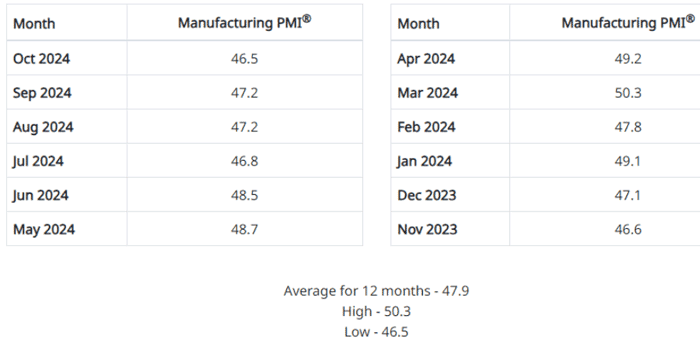The US Purchasing Managers Index (PMI) for October was released Friday by the Institute for Supply Management (ISM), and came in at a level of 46.5, down from 47.2 in September, and again below the key 50 mark that separates US manufacturing expansion from contraction.
Supply Chain Digest Says... |
 |
|
| Said Timothy Fiore, Chair of the Institute for Supply Management Manufacturing Business Survey Committee: “Demand remains subdued, as companies continue to show an unwillingness to invest in capital and inventory due to concerns (for example, inflation resurgence) about federal monetary policy direction in light of the fiscal policies proposed by both major parties." |
|
 |
|
What do you say? |
|
| Click here to send us your comments |
|
| |
|
| Click here to see reader feedback |
|
|
|
The October level of 46.5 is also the lowest monthly score so far in 2024.
The US PMI had previously been in contraction territory for 17 straight months until it poked its head into expansion in March, but has fallen back to contraction now in each of the last seven months.
The overall economy continued in expansion for the 54th month after one month of contraction in April 2020. The PMI tracks closely but not exactly with the overall US economy.
A Manufacturing PMI above 42.5, over a period of time, generally indicates an expansion of the overall economy, according to ISM.
The other PMI numbers we track were also mostly negative.
That starts with the New Order Index, which remained in contraction territory with a score of 47.1, one percentage points higher than the 46.1 recorded in September, but still a strong negative sign for future US manufacturing activity.
The October score of the Production Index was 46.2, which was 3.6 percentage points lower than September’s figure of 49.8, as manufacturing output once was in contraction status.
The Prices Index, however, went into expansion territory for just the second time this year, registering 54.8, up a big 6.5 percentage points compared to the reading of 48.3 in August. That means most companies saw an increase in the cost of components, materials and other inputs (below 50 = falling prices) in Ocober.
The Backlog of Orders Index registered 42.3, down 1.8 percentage points compared to the 44.1 recorded in September. That means the order book of most companies is shrinking, with the index level still well below the 50 mark and falling.
The Supplier Deliveries Index remained in “slower” territory, registering 52.2, which was 0.2 percentage point higher than the 50.2 recorded in September.
Supplier Deliveries is the only ISM index that is inversed, with a reading of above 50 indicating slower deliveries, which is typical as the economy improves and customer demand increases - or the reverse.
The Inventories Index came in at 42.6, down 1.3 percentage points compared to September’s reading of 43.9., with the score below 50 indicating inventory levels at companies are decreasing.
Said Timothy Fiore, Chair of the Institute for Supply Management Manufacturing Business Survey Committee: “Demand remains subdued, as companies continue to show an unwillingness to invest in capital and inventory due to concerns (for example, inflation resurgence) about federal monetary policy direction in light of the fiscal policies proposed by both major parties. Production execution eased in October, consistent with demand sluggishness.”
(See More Below)
|
CATEGORY SPONSOR: SOFTEON |
|
|
|
|
|
As always, the ISM report provides a graphic of the PMI scores the last 12 months, which as can be seen indicates the measure has been below the key 50 for the past year and actually since November 2022, with the exception of March 2024. It is now averaging just 47.9 over the past year.
US PMI Last 12 Months

Source: ISM
Of the 18 sectors tracked by ISM, just five reported growth in September. They are, in order: Apparel, Leather & Allied Products; Food, Beverage & Tobacco Products; Petroleum & Coal Products; Computer & Electronic Products; and Miscellaneous Manufacturing.
As always, there were some interesting comments from PMI survey respondents.
“Right-sizing continues. Contingency plans have been formulated to anticipate trade policies that will impose tariffs on key materials.,” said one manager in the chemicals sector.
“Sales have been very slow the past six months. Interestingly, though, inquiries are up more than 30 percent from a year ago. This indicates there is pent-up demand, but customers are skittish about national and global economic conditions. We are hearing directly from customers that they need to order equipment to satisfy their requirements but are going to keep projects as long as possible before pulling the trigger,” added a respondent in the machinery industry.
Finally, a manager in the transportation equipment industry observed that “Market demand has significantly decreased in the second half of 2024 and is expected to be soft through the first quarter of 2025. Although inflation has stabilized and returned to historical levels, and interest rates are decreasing, there appears to be a general pessimism in the economy that is driving customers to be more restrictive in their capital expenditures, including investment in commercial vehicles.”
What are your thoughts on the September PMI? Let us know your thoughts at the Feedback section below.
Your Comments/Feedback
|

